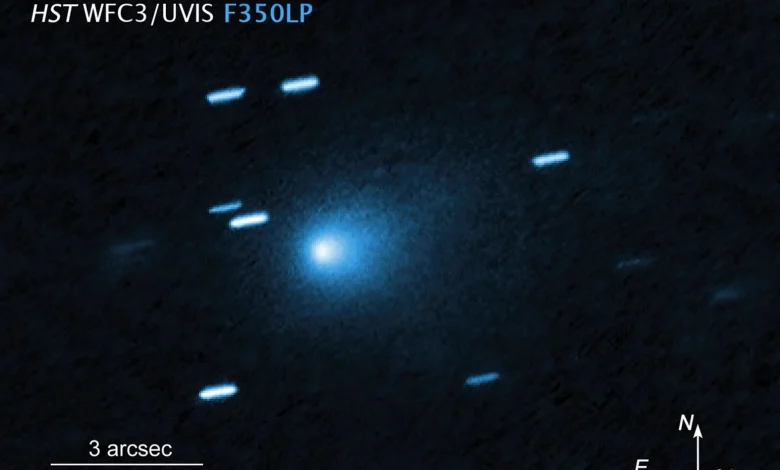Comet 3I/ATLAS Perihelion Update

Comet 3I/ATLAS reached perihelion on October 30, 2025. While astronomers around the world had been watching this rare interstellar traveler, the comet was too close to the Sun for Earth-based observations to be made. Only the third known object to enter our Solar System from another star system, 3I/ATLAS became the focus of a special SETI Live episode featuring SETI Institute planetary astronomer Dr. Franck Marchis and SETI Institute cometary scientist Dr. Ariel Graykowski. The discussion unpacked what scientists had learned so far about this comet’s origin, structure, and composition – and what its brief visit might reveal about the formation of other planetary systems.
Discovery and Initial Observations
Comet 3I/ATLAS was discovered on July 1, 2025, by the Asteroid Terrestrial-impact Last Alert System (ATLAS) telescope in Chile. The designation “3I” marks it as the third confirmed interstellar object — following 1I/‘Oumuamua in 2017 and 2I/Borisov in 2019. Its detection reignited global interest in studying how interstellar bodies differ from comets native to our Solar System.
At discovery, 3I/ATLAS was faint: around 17th to 18th magnitude, and appeared only slightly extended. Astronomers debated whether its apparent size reflected an active coma (a cloud of gas and dust surrounding the solid nucleus) or a bare nucleus roughly ten kilometers wide. Within days, follow-up observations confirmed the presence of a coma, indicating active sublimation (the direct transition of solid ice to gas) even at large distances from the Sun.
This early activity suggested that 3I/ATLAS contains highly volatile compounds such as carbon dioxide (CO₂) and carbon monoxide (CO), which sublimate at much lower temperatures than water ice. Such volatiles are common in long-period comets, but their prominence in an interstellar body helps scientists probe the diversity of cometary chemistry across planetary systems.
Composition and Activity
Spectroscopic measurements (observations that split light into its component wavelengths) revealed that the comet’s coma was dominated by CO₂ gas, with only minimal traces of water vapor. At a distance of roughly three astronomical units (AU) from the Sun, this composition is unusual, since water ice typically begins to sublimate at that range. Researchers suggest that evaporative cooling may be responsible, as CO₂ sublimates rapidly, absorbing heat from the surface and lowering the local temperature, thereby delaying the onset of water sublimation.
Another possible explanation lies in the comet’s composition and origin. Formed under unknown conditions in another star system, 3I/ATLAS may contain ices with different crystalline structures or chemical impurities compared to Solar System comets. Over millions of years in interstellar space, cosmic radiation can further alter ice chemistry, producing physical behaviors distinct from those seen in native comets.
Orbital Behavior and Non-Gravitational Forces
Currently, 3I/ATLAS lies behind the Sun as seen from Earth, making it temporarily invisible to ground-based telescopes. Its orbit – a hyperbolic path that ensures it will not return to our Solar System – takes it just inside the orbit of Mars. As it passes perihelion, astronomers track its motion using minor deviations from purely gravitational motion. These non-gravitational accelerations arise when jets of gas and dust escaping from the surface act like tiny thrusters, subtly altering the comet’s trajectory.
Such behavior is typical among active comets, reinforcing the importance of continuous monitoring. Through the Unistellar Network, a global community of citizen astronomers coordinated by the SETI Institute, scientists collect near-continuous photometric data, measuring changes in brightness that signal new outbursts or fragmentation events.
Just before 3I/ATLAS became unobservable, Unistellar data showed an unexpected surge in brightness. This brightening exceeded predictions, hinting at either a sudden outburst of gas or an increase in surface activity. Space-based solar observatories later confirmed that the brightening persisted through perihelion, suggesting a significant change in the comet’s physical state.
The Nickel–Iron Mystery
Spectra obtained with the European Southern Observatory’s Very Large Telescope (VLT) revealed another surprise: an unusually high nickel-to-iron ratio in the gas phase. In most comets of the Solar System, nickel and iron appear together in roughly solar proportions, released from organometallic compounds that sublime at low temperatures. Early measurements of 3I/ATLAS showed strong nickel emission but weak iron, depicting a puzzling imbalance that began to normalize as the comet approached the Sun.
This evolving ratio may reflect temperature-dependent release of these metals or differences in the chemical pathways that formed their original ices. Either way, it provides a rare glimpse into the metal content of interstellar matter and serves as a benchmark for future studies of cometary composition beyond our Solar System.
Looking Ahead
With its orbit now carrying it back toward interstellar space, 3I/ATLAS will soon fade from view. However, the data collected during its passage, from amateur astronomers and major observatories alike, will inform upcoming missions such as ESA’s Comet Interceptor, designed to rendezvous with a future interstellar object.
“Each one of these discoveries is a rehearsal,” said Dr. Marchis. “We are learning how to observe, interpret, and react quickly so that next time, we’ll be ready to send a spacecraft.”
Watch the full conversation on SETI Live.





